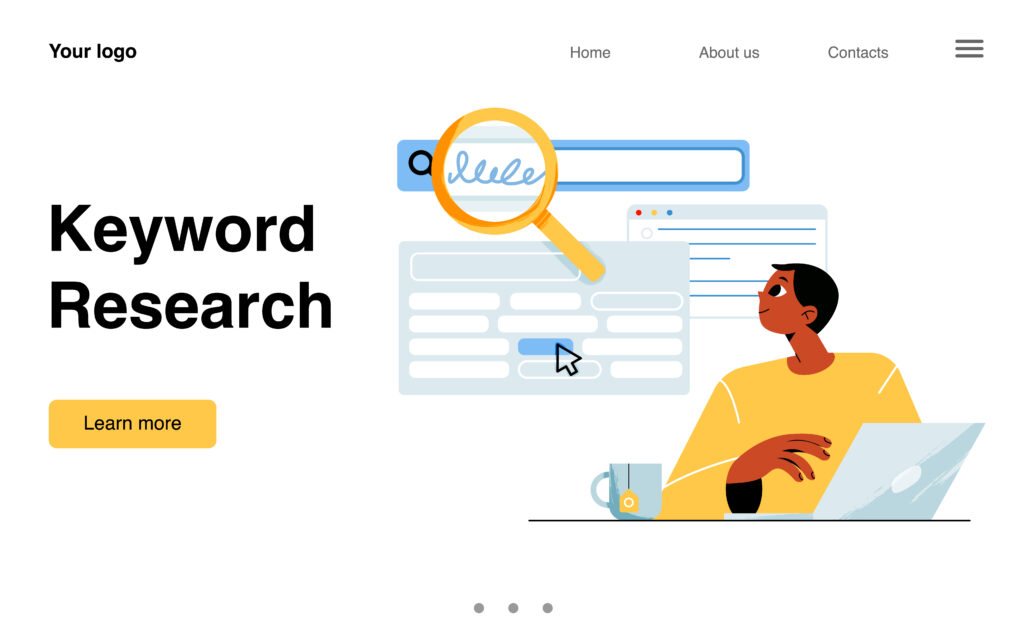Did you know that 97% of consumers search online to find local businesses? Yet most small businesses are missing out on this goldmine of local customers because they don’t understand how to leverage local SEO effectively.
If you’re a small business owner struggling to compete with larger companies or national chains, local SEO is your secret weapon. This comprehensive guide will show you exactly how to dominate your local market and attract more customers than ever before.
What is Local SEO and Why Does It Matter?
Local SEO (Search Engine Optimization) is the practice of optimizing your online presence to attract customers from local searches. When someone searches for “best pizza near me” or “dentist in [your city],” local SEO determines whether your business appears at the top of those results.
The numbers speak for themselves:
- 46% of all Google searches have local intent
- 76% of people who search for local businesses visit within 24 hours
- 28% of local searches result in a purchase
- Local searches are 3x more likely to convert than non-local searches
For small businesses, local SEO levels the playing field. While you can’t compete with Amazon’s marketing budget, you can absolutely dominate your local market with the right strategy.

Understanding Google’s Local Search Algorithm
Google uses three primary factors to determine local search rankings:
1. Relevance
How well your business matches what the searcher is looking for. This includes your business category, services offered, and content relevance.
2. Distance
The physical proximity of your business to the searcher’s location or the location mentioned in their search query.
3. Prominence
How well-known and authoritative your business is both online and offline. This includes reviews, backlinks, and overall online reputation.
Understanding these factors is crucial because your local SEO strategy must address all three to achieve maximum results.
The 8-Step Local SEO Domination Strategy
Step 1: Claim and Optimize Your Google Business Profile
Your Google Business Profile (formerly Google My Business) is the foundation of local SEO success. Businesses with complete profiles are 2.7x more likely to be considered reputable by consumers.
Complete Optimization Checklist:
Business Information:
- Accurate business name (exactly as it appears on your storefront)
- Full address with proper formatting
- Local phone number (not toll-free)
- Website URL
- Accurate business hours (including holiday hours)
- Business category selection (primary and secondary)
Enhanced Features:
- Upload high-quality photos (exterior, interior, products, team)
- Add business description with local keywords
- List all services or products offered
- Include attributes (wheelchair accessible, Wi-Fi, parking, etc.)
- Add booking links or appointment scheduling
- Enable messaging feature
Pro Tip: Businesses with photos get 42% more requests for directions and 35% more click-throughs to their websites.

Step 2: Develop a Local Keyword Strategy
Local keyword research requires a different approach than traditional SEO. You need to think like your local customers and understand how they search for businesses like yours.
Local Keyword Types:
1. Location + Service Keywords:
- “plumber in [city]”
- “[city] dentist”
- “restaurants near [neighborhood]”
2. “Near Me” Keywords:
- “coffee shops near me”
- “auto repair near me”
- “best pizza near me”
3. Local Intent Keywords:
- “[city] wedding photographer”
- “emergency locksmith [area]”
- “[neighborhood] dog grooming”
Keyword Research Tools:
- Google Keyword Planner (set location filters)
- Ahrefs or SEMrush (local keyword features)
- Google Autocomplete and “People Also Ask”
- Local customer surveys and interviews
Research Process:
- List your core services/products
- Combine with location modifiers
- Analyze search volume and competition
- Prioritize based on relevance and difficulty
- Create keyword clusters for content planning
Step 3: Create Location-Specific Content
Content is what separates the winners from the wannabes in local SEO. Businesses that blog get 97% more backlinks and significantly more local traffic.
High-Impact Local Content Types:
1. Location Pages:
- Dedicated pages for each service area
- Include local keywords naturally
- Add location-specific information
- Include customer testimonials from that area
2. Local Resource Guides:
- “Ultimate Guide to [Your City]”
- “Best [Your Industry] Tips for [Local Area] Residents”
- Local event coverage and sponsorships
3. Customer Success Stories:
- Case studies featuring local clients
- Before/after photos with local context
- Video testimonials from community members
4. Community-Focused Content:
- Local news and events
- Community involvement stories
- Partnerships with local businesses
- Sponsorship announcements
Content Optimization Tips:
- Include city/neighborhood names naturally throughout content
- Add local landmarks and points of reference
- Use local terminology and phrases
- Include local images and videos
- Link to other local businesses and organizations
Step 4: Build Local Citations and NAP Consistency
Citations are mentions of your business name, address, and phone number (NAP) across the web. Consistent citations across 50+ directories can significantly boost local rankings.
Primary Citation Sources:
- Google Business Profile
- Apple Maps
- Bing Places
- Facebook Business Page
- Yelp
- Yellow Pages
- Industry-specific directories
Local Citation Strategy:
- Audit existing citations for accuracy
- Fix inconsistencies in NAP information
- Submit to major directories first
- Target niche directories in your industry
- Monitor and maintain citations regularly
Citation Management Tools:
- Moz Local
- BrightLocal
- Whitespark
- Yext

Step 5: Generate and Manage Online Reviews
Online reviews are crucial for local SEO success. Businesses with more reviews rank higher in local search results, and 90% of consumers read reviews before visiting a business.
Review Generation Strategy:
1. Make It Easy to Review:
- Create direct links to your Google Business Profile
- Send follow-up emails with review requests
- Include QR codes on receipts or business cards
- Train staff to ask for reviews at optimal moments
2. Timing is Everything:
- Ask for reviews immediately after positive experiences
- Follow up 2-3 days after service completion
- Send automated review requests via email
3. Incentivize Honestly:
- Offer small discounts for honest reviews
- Enter reviewers into monthly drawings
- Provide exclusive offers to loyal customers
Review Management Best Practices:
- Respond to ALL reviews (positive and negative)
- Address negative reviews professionally and quickly
- Thank customers for positive feedback
- Use keywords naturally in review responses
- Monitor reviews across all platforms
Step 6: Optimize for Voice Search and Mobile
With 55% of teens and 41% of adults using voice search daily, optimizing for conversational queries is essential for local dominance.
Voice Search Optimization:
1. Target Conversational Keywords:
- “Where’s the best coffee shop near me?”
- “What time does [business] close?”
- “How do I get to [business name]?”
2. Create FAQ Content:
- Answer common local questions
- Use natural, conversational language
- Include location-based FAQ sections
3. Optimize for Featured Snippets:
- Structure content to answer specific questions
- Use clear headings and bullet points
- Provide concise, direct answers
Mobile Optimization Essentials:
- Ensure fast loading speeds (under 3 seconds)
- Use responsive design
- Make phone numbers clickable
- Simplify navigation and contact forms
- Include clear calls-to-action
Step 7: Build Local Backlinks and Partnerships
Local backlinks from reputable community websites significantly boost your local SEO authority.
Local Link Building Strategies:
1. Community Involvement:
- Sponsor local events and charities
- Join local business associations
- Participate in community boards
2. Local Media and PR:
- Pitch stories to local newspapers
- Appear on local radio or TV shows
- Share expert opinions on local issues
3. Business Partnerships:
- Partner with complementary local businesses
- Exchange referrals and links
- Collaborate on community projects
4. Resource Page Links:
- Get listed on local resource pages
- Chamber of Commerce directories
- Local government websites
- Tourism and visitor bureaus
Step 8: Track, Measure, and Optimize Performance
Successful local SEO requires continuous monitoring and optimization based on data-driven insights.
Essential Local SEO Metrics:
Ranking Metrics:
- Local pack rankings for target keywords
- Organic search rankings
- Voice search visibility
- Map pack appearances
Traffic Metrics:
- Local organic traffic growth
- Google Business Profile views
- Website traffic from local searches
- Direction requests and calls
Conversion Metrics:
- Lead generation from local searches
- Phone calls from search
- Store visits and foot traffic
- Online-to-offline conversions
Tools for Tracking:
- Google Analytics (with location tracking)
- Google Search Console
- Google Business Profile Insights
- Local rank tracking tools (BrightLocal, Whitespark)

Advanced Local SEO Tactics
Schema Markup for Local Businesses
Implement local business schema markup to help search engines understand your business information better. This includes:
- LocalBusiness schema
- Review schema
- Event schema for local events
- FAQ schema for common questions
Geo-Targeted Landing Pages
Create specific landing pages for each location or service area you serve. Each page should include:
- Location-specific content and keywords
- Local contact information
- Area-specific testimonials
- Relevant local images
Local Social Media Strategy
Leverage social media platforms with location features:
- Instagram location tags and local hashtags
- Facebook check-ins and local events
- LinkedIn local business networking
- Nextdoor neighborhood engagement
Common Local SEO Mistakes to Avoid
- Inconsistent NAP information across directories
- Keyword stuffing in business descriptions
- Ignoring negative reviews or responding defensively
- Using fake reviews or incentivizing dishonest feedback
- Neglecting mobile optimization
- Focusing only on Google and ignoring other platforms
- Not tracking and measuring results
Local SEO Success Story
Sarah’s Bakery, a small family-owned business, implemented this local SEO strategy and achieved remarkable results in just 6 months:
- 312% increase in local search visibility
- 89% growth in Google Business Profile views
- 156% more phone calls from search
- 47% increase in foot traffic
- $50,000 additional revenue attributed to local search
Their key success factors? Consistent implementation, regular review generation, and community involvement that earned valuable local backlinks.
Your Local SEO Action Plan
Ready to dominate your local competition? Follow this 90-day implementation plan:
Days 1-30: Foundation Building
- Claim and optimize Google Business Profile
- Conduct local keyword research
- Audit and fix NAP consistency
- Set up review generation process
Days 31-60: Content and Citations
- Create location-specific content
- Submit to major local directories
- Launch review generation campaign
- Begin local link building efforts
Days 61-90: Optimization and Expansion
- Analyze performance data
- Optimize based on results
- Expand to additional platforms
- Scale successful strategies
Ready to Dominate Your Local Market?
Local SEO isn’t just about rankings—it’s about connecting with your community and growing your business. When implemented correctly, this strategy doesn’t just help you compete with larger businesses; it helps you win.
The businesses dominating local search results aren’t necessarily the biggest or most established. They’re the ones who understand that local SEO is a long-term strategy that requires consistency, authenticity, and genuine commitment to serving their local community.
Need help implementing these local SEO strategies? Our team at Vtechify has helped hundreds of small businesses achieve local search domination. We understand the unique challenges small businesses face and have the proven strategies to help you succeed.
Contact us today for a free local SEO audit and discover exactly what it will take to dominate your local competition.
About the Author: The Vtechify team specializes in helping small businesses leverage digital marketing to compete and win in their local markets.
Ready to get started? Download our free “Local SEO Checklist for Small Businesses” and begin your journey to local search dominance today.

